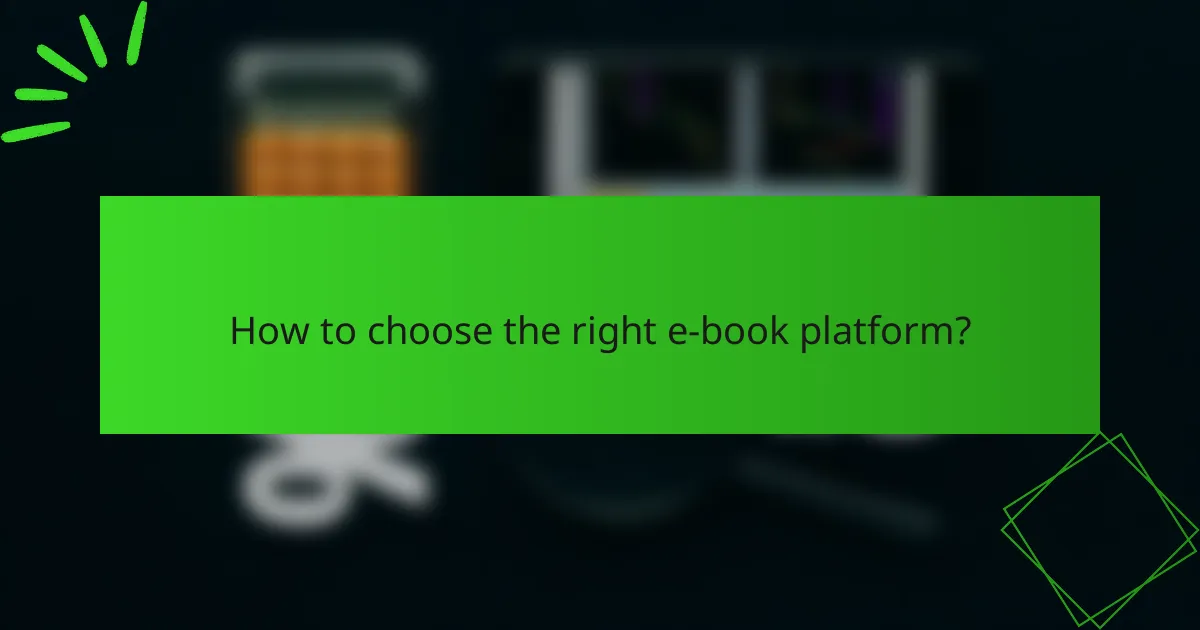In the ever-evolving world of digital publishing, selecting the right e-book platform is crucial for authors looking to maximize their reach and profitability. With options like Amazon Kindle Direct Publishing and Kobo Writing Life, each platform offers distinct advantages tailored to various needs. Additionally, effective design plays a vital role in enhancing the reader’s experience, emphasizing the importance of professional formatting and engaging visuals.

What are the best e-book platforms in Canada?
The best e-book platforms in Canada include Amazon Kindle Direct Publishing, Kobo Writing Life, Apple Books, Smashwords, and Draft2Digital. Each platform offers unique features and benefits that cater to different types of authors and readers.
Amazon Kindle Direct Publishing
Amazon Kindle Direct Publishing (KDP) is a leading platform for self-publishing e-books. It allows authors to publish their books directly on Amazon, reaching millions of readers. KDP offers competitive royalty rates, typically around 70% for books priced between CAD 2.99 and CAD 9.99.
Authors can easily format their manuscripts using KDP’s guidelines and upload them in various formats. Additionally, KDP provides promotional tools like Kindle Countdown Deals and Free Book Promotions to help boost visibility.
Kobo Writing Life
Kobo Writing Life is another popular platform in Canada, especially for authors targeting the Canadian market. It allows authors to publish e-books and distribute them to Kobo’s global network of retailers. Kobo offers a royalty rate of up to 70% depending on the price range.
One key advantage of Kobo Writing Life is its user-friendly interface, which simplifies the publishing process. Authors can also access detailed sales reports and promotional opportunities through Kobo’s marketing programs.
Apple Books
Apple Books provides a robust platform for authors looking to reach readers on Apple devices. By publishing through Apple Books, authors can tap into a large audience of iPhone and iPad users. The platform offers a royalty rate of 70% on all sales.
To publish on Apple Books, authors must use the iTunes Connect platform, which requires formatting the e-book according to Apple’s specifications. This platform is ideal for authors who want to create a visually appealing reading experience with rich media content.
Smashwords
Smashwords is a versatile e-book distribution platform that allows authors to publish and distribute their works to various retailers, including Barnes & Noble and Apple Books. It offers a royalty rate of up to 80% depending on the distribution channel.
One of the main benefits of Smashwords is its extensive distribution network, which can significantly increase an author’s reach. However, authors must adhere to specific formatting guidelines to ensure their e-books are accepted.
Draft2Digital
Draft2Digital is a user-friendly platform that simplifies the e-book publishing process. It allows authors to publish their works and distribute them to multiple retailers, including Kobo and Apple Books, with a royalty rate of around 60% to 70% depending on the retailer.
Draft2Digital offers free formatting tools and a straightforward dashboard for tracking sales and royalties. This platform is particularly appealing for authors who want an easy entry into the e-book market without the complexities of self-publishing on multiple sites.

How to choose the right e-book platform?
Choosing the right e-book platform involves evaluating factors such as distribution reach, royalty rates, user interface, and available marketing tools. These elements can significantly impact your e-book’s visibility, profitability, and overall success in the digital marketplace.
Distribution reach
Distribution reach refers to how widely your e-book can be sold across various platforms and retailers. Consider platforms that offer access to major online bookstores like Amazon, Apple Books, and Google Play, as well as smaller niche markets. A broader distribution can increase your chances of reaching more readers.
Some platforms, like Amazon Kindle Direct Publishing, provide extensive global reach, while others may focus on specific regions. Evaluate where your target audience is most likely to shop and choose a platform that aligns with that demographic.
Royalty rates
Royalty rates determine how much you earn from each sale of your e-book. Most platforms offer royalty rates ranging from 35% to 70%, depending on factors like pricing and distribution channels. Understanding these rates is crucial for calculating potential earnings.
For example, Amazon offers a 70% royalty rate for e-books priced between $2.99 and $9.99, while other platforms may have different structures. Always read the fine print to avoid unexpected fees that could affect your profits.
User interface
A user-friendly interface is essential for both authors and readers. Look for platforms that provide intuitive tools for uploading, formatting, and managing your e-book. A simple interface can save time and reduce frustration during the publishing process.
Additionally, consider how easy it is for readers to navigate the platform. A seamless reading experience can encourage more purchases and positive reviews, enhancing your book’s reputation.
Marketing tools
Effective marketing tools can help promote your e-book and increase sales. Many platforms offer built-in promotional features, such as discount options, advertising opportunities, and social media integration. Evaluate what marketing resources are available to maximize your book’s visibility.
For instance, some platforms allow you to run targeted ads or participate in promotional events that can boost your e-book’s reach. Take advantage of these tools to create a comprehensive marketing strategy that aligns with your goals.

What are effective e-book design tips?
Effective e-book design tips focus on creating a visually appealing and user-friendly reading experience. Key elements include professional formatting, engaging cover designs, mobile optimization, and the incorporation of interactive features.
Use professional formatting tools
Utilizing professional formatting tools is essential for producing a polished e-book. Software like Adobe InDesign, Scrivener, or Vellum can help ensure consistent typography, spacing, and layout. These tools often provide templates that adhere to industry standards, making it easier to create a professional look.
When formatting, pay attention to font choices, line spacing, and margins. Aim for a clean, readable layout that enhances the reading experience. Avoid cluttered designs that can distract from the content.
Choose engaging cover designs
An engaging cover design is crucial for attracting readers. It should reflect the e-book’s content and genre while standing out in digital marketplaces. Consider hiring a professional designer or using design platforms like Canva or Adobe Spark to create a compelling cover.
Elements to focus on include color schemes, typography, and imagery. Ensure that the title and author name are easily readable, even in thumbnail size. A well-designed cover can significantly impact sales and reader interest.
Optimize for mobile reading
With a significant number of readers using mobile devices, optimizing e-books for mobile reading is vital. Ensure that text is legible on smaller screens by using appropriate font sizes and responsive layouts. Test your e-book on various devices to confirm readability and usability.
Consider using formats like EPUB, which adapt well to different screen sizes. Avoid overly complex designs that may not translate well on mobile devices. Simple, clean layouts enhance the reading experience across platforms.
Incorporate interactive elements
Incorporating interactive elements can enhance reader engagement and make the e-book more dynamic. Features such as hyperlinks, embedded videos, and quizzes can provide additional value and interactivity. These elements encourage readers to explore content beyond the text.
However, use interactive features judiciously. Overloading an e-book with too many elements can distract from the main content. Aim for a balance that enhances the reading experience without overwhelming the reader.

What are common e-book pricing strategies?
Common e-book pricing strategies include free promotions and price anchoring. These methods help authors and publishers attract readers, increase sales, and establish perceived value.
Free promotions
Free promotions involve temporarily offering an e-book at no cost to boost visibility and attract new readers. This strategy can lead to increased downloads, which may enhance rankings on platforms like Amazon or Apple Books.
Consider running a free promotion for a limited time, such as a few days or a week. This can create urgency and encourage readers to download the book before the offer ends. Additionally, it can help build an email list for future marketing efforts.
Price anchoring
Price anchoring is a strategy where a higher-priced item is presented alongside a lower-priced e-book to influence perceived value. By positioning a premium version or a series at a higher price, the lower-priced option appears more attractive.
For example, if an e-book is priced at $9.99 but is shown next to a deluxe edition at $19.99, readers may be more inclined to purchase the standard version. This technique can effectively increase sales of the lower-priced e-book while maintaining a higher price point for premium offerings.










